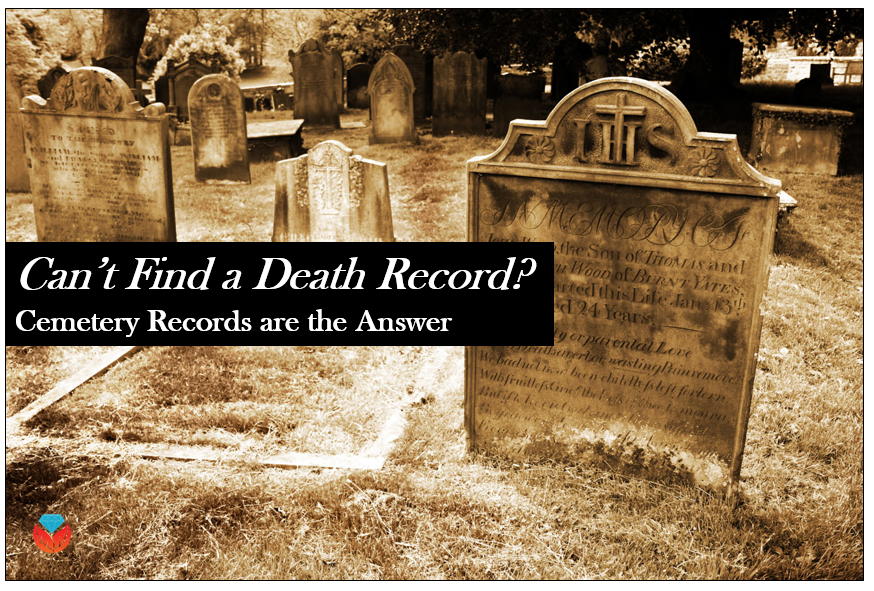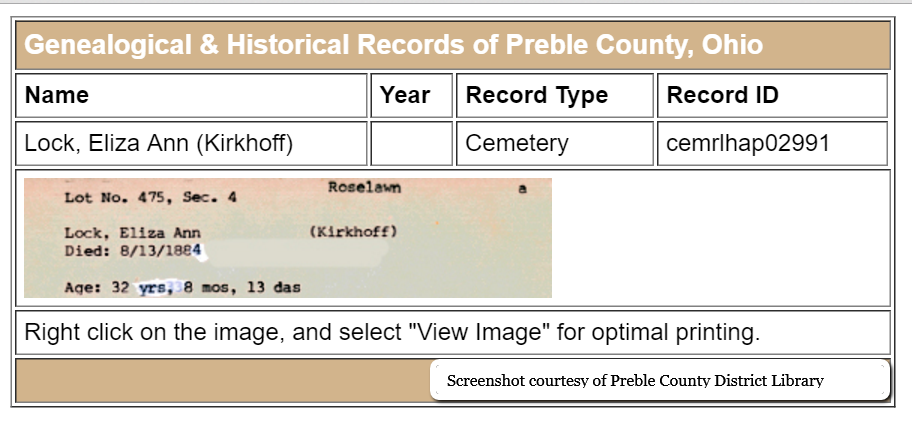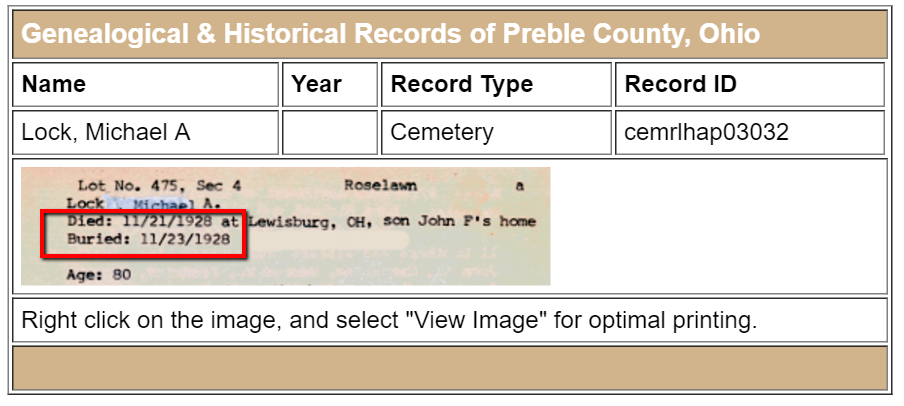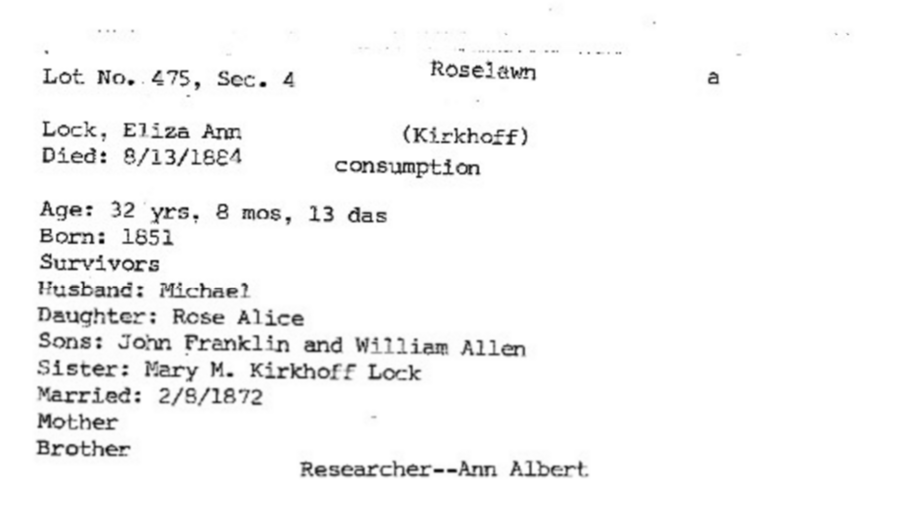 Cemetery records are a great alternative when you can’t find a death record. Here’s how to find them!
Cemetery records are a great alternative when you can’t find a death record. Here’s how to find them!
Genealogists are always on the hunt for records about the deaths of their ancestors. Death records sometimes offer a cause of death, birth information, and parents’ names. However, when a death record cannot be found, was never created, or was lost in a disaster, where should we look next? The cemetery, of course!
Genealogy Gems reader Brenda wrote us the following message:
My father and I were visiting the cemeteries in Preble County, Ohio. We decided to take a drive down Lock Road, which is named for my ancestors. We visited the home of my two times great-grandparents, Michael and Eliza Ann Lock. While visiting with the new home owner, they mentioned the tombstone located in the fence row behind the barn. The tombstone said “Eliza wife of Michael Lock.” The tombstone is hard to read, but I was also able to make out a “13” engraved on it and I know she died August 13, 1884. My problem is that there is also a tombstone listing her with her husband who died November 21, 1928 and a separate marker that says “Mother” marking a plot in Roselawn Cemetery in Lewisburg, Ohio. Would they have moved her body when her husband died or is she still buried on the homestead? I found records at the Preble County Library that references Eliza Lock and the cemetery plot in the Roselawn Cemetery. How do I know where she is actually buried?
Just short of ground penetrating radar and exhuming the body, we may never know for sure where someone is buried. There are some things we can do, however, to get the best answer possible and maybe find some new clues in the process.
Burial Locations of the Past
According to Ohio laws in 1884, burial regulations were made on the township or village level.[1] Further, it was permissible to bury a body within 200 yards of a dwelling if the home owner gave permission.[2] [Research tip: To search the law books of a targeted area, search Google Books with a keyword phrase like Ohio laws 1884.]
It was not uncommon to bury a person on the family farm in the old days. Many people had their own family cemeteries on their property. In fact, some states still allow private burials even today. In Ohio, a person seeking to have a private burial on their property should contact the county clerk. Read more about the current Ohio burial laws here.
Possible Theories
Theory #1: Eliza was buried at the farm and a marker was placed on her grave. Her husband died in 1928 and was buried in Roselawn Cemetery. The family decided to place a marker that had both of their names on it, even though Eliza’s body was left at the farm.
Theory #2: Eliza was buried at the farm and a marker was placed on her grave. Her husband died in 1928 and was buried in Roselawn Cemetery. The family moved Eliza’s body to the same plot in Roselawn and had a stone made for both of them.
Theory #3: Eliza was buried at Roselawn Cemetery and a small stone was placed to mark the grave. Then, forty-four years later when Michael died, the family removed the original stone and replaced it with a new one which was inscribed with both of their names. What did the family do with the old marker for Eliza? They took it home to the farm as a memento.
Using Cemetery Records to Confirm A Theory
We can check the burial or cemetery records for Roselawn Cemetery to determine who is buried in the plot of Michael Lock, who purchased the plot, and maybe some more helpful hints.
Cemetery records can usually be found in a cemetery office, a library, online, or in many cases, the offices or home of the township trustees.
First, Google the cemetery name and get a phone number. When calling the cemetery office, be ready with the name of the individual and the death date if known. If a record is found, ask for a copy to be sent to you and be sure to offer to pay the cost of mailing it to you.
If you are unable to reach anyone in the cemetery office, try a quick online search. Many local county organizations are digitizing and indexing these records to put online. I searched for “Preble County Ohio genealogy,” and found a website dedicated to historical and genealogical records for Preble county.
A quick search for Eliza Lock provided a hit!

I noticed that there was a plot location and a death date, but not a burial date like I had seen on Michael’s index card. Michael’s card had two dates.

I checked many other cemetery records in this database. Several records created around the same time as Eliza’s death in 1884 also had no burial date. At first, I wondered if a record not having a burial date meant that the body wasn’t actually buried there. However, there were far too many records that did not include a burial date for this to be true.
I also noticed that this index card was a digital image and I wondered if it was created from some other source. It even seemed to have been altered with white-out. As with all genealogy research, if there is an original source, it should be found. In this case, I want to find out where these index cards came from. Were they created by someone who was looking at a ledger book? If so, then I want to see or view an image from the ledger book.
Locating the Original Cemetery Record Source
Sources come in two varieties – an original source and a derivative source. An original source is the one created at the time of the event. A derivative source is a record created later from the original, such as a transcription or abstraction. When a derivative is made, there is room for errors. This is one reason it is important to find the original source if at all possible. When it is not possible, you can use the derivative source as your proof, but you would indicate that it was a derivative and not an original.
Since this index was found at the library website, I gave them a call first. The Preble County Room assistant told me that the images were taken directly from the files held at the cemetery (the original source). The cemetery kept little index cards as their records. Volunteers later digitized those cards and uploaded them to the website (copy of an original source). According to the person I spoke to, there is no other ledger or record book that they know of. She did tell me that the image on the internet is only the top half of the digitized record (an abstract). This is yet another reason to discover how a record was made. If I had assumed this was the original record in its entirety, I would have missed some important clues.
She happily emailed me the full image of the index card (said to be a digital image of the original index card) and look what we see! [See image below]

The full record held a lot more information. When I compared the lot number of Michael and Eliza, they were the same. According to this cemetery record, it seems that Eliza’s body is buried in the same plot as her husband at the cemetery. I speculate that when Michael died, the family decided to remove the original tombstone marking Eliza’s grave, put up a new one in its stead, and take the old tombstone back home instead of discarding it.
Cemetery records are a great asset to any family history research and can often hold new information. Start today and see what you can find!
Research Tip: Did you know that in many small Ohio townships, the cemetery record books may be at the home or office of a local township trustee? The cemeteries sometimes fall under the township responsibilities, instead of county or village. In my own township, the original cemetery books were once held by the local funeral director. Now, they are held by a township trustee who is in charge of the cemeteries. You can find the names of township trustees by performing a Google search like Harrison Township Preble County Ohio township trustees.
More Gems on Cemeteries and Cemetery Records
Premium Episode 69 – Cemetery Records with Deceased Online
Merry Cemetery Displays ‘Dirty Little Secrets’ of the Dead
Reviving a Memorial Day Tradition: Paper Flowers
ARTICLE REFERENCES
[1] The Revised Laws of Ohio: Containing All the Sections of the Statutes in Annual Volumes of Ohio Laws from Seventy-seven to Eighty-one, Inclusive, Arranged on the Plan of the Revised Statutes, 1884, Google Books, (https://books.google.com/books?id=QwZIAQAAMAAJ&printsec=frontcover#v=onepage&q&f=false : accessed 20 Jun 2016,) page 87.
[2] Ibid., page 195.





On my father’s burial record the only things that are correct are his name and the date and location of burial. He died in Washington, D. C. on a job interview. I have not yet found the death certificate. It apparently took a few days to decide who he was and contact us. His place of birth is listed at the city the cemetery is in, and he is listed as widowed. That is understandable since his first wife is buried there and the cemetery would not have known of a later marriage. The person listed as physician is the superintendent of the crematory. The date of death doesn’t match either the date of death or the date of cremation both of which are listed in the other documents they have. His parents are buried in the same cemetery but they are not listed. I am sending them the correct information for their files.
The upshot is “Don’t believe everything you read, even if it is an official document.
A great reminder, Alison! No document, record, or source can automatically be assumed to be correct. Each record, or piece of information on a record, needs to be evaluated. Sometimes, we can pair a death record with a cemetery or burial record to get a more likely accurate piece of information…but not always! Thanks for the reminder and thank you for reading!
I’m really glad that I read this article since several of my husband’s ancestors lived in Preble County. This is very valuable information for me to use in my research.
Thank you
You are very welcome, Shirley! Thanks for reading!
Great information. Thank you! My situation is probably not unique, but it confounds us nevertheless. My aunt died last July in Ipswich, Massachusetts. We only found out after the fact from a distant relative. I have tried to find an obituary or burial record but have been hitting dead ends. The obvious answer is to ask her surviving sons, who are not speaking – to any of us! Rumor has it that one does not want the other to know that she has died so as to avoid claim to any inheritance, sadly. I am a beginning genealogist and do not know where to investigate next.
Hello Martha! Wow! Well, I think your case is definitely unique! When dealing with a recent death, obituaries are usually a great source. However, if someone is trying to keep the death hidden, then they likely would not have had an obit created. I think you have two options: funeral records and cemetery records. The person would have had to have at least been buried and perhaps a local cemetery has that information. There may have also been a funeral, or at least, the body would have been prepared or cremated even if there was no formal funeral. I am not sure if you can get records from funeral homes that only prepare the body. I am unsure if there are any limitations due to privacy laws, but I would give that a try next. Good luck!
My maternal grandparents were both born in Indiana, but moved to Iowa where their children were born. Unfortunately, the first child died at age 3 of diphtheria. They took his body back to Indiana to be buried near other family members. About 10 years later, my grandmother died, and her body was also returned to Indiana to lie next to her little son. My grandfather lived about 30 more years and never remarried, and when he died he also was buried in Indiana. In the early 1960s we went to visit him, and we took him to Indiana to visit the graves of his wife and son. When we questioned him about some of the information on grave markers that did not seem right, he remarked “Well, you can not always believe what you see on headstones.” Since then, while doing genealogy research, I have often realized the truth of what he said, as I have found many an incorrect marker. I suppose once the stone had been carved, it would be too difficult or expensive to redo it.
Marilyn, You are absolutely right about tombstones sometimes being incorrect. I was once told that if a person died in January, sometimes the year on the tombstone would be from the previous year because the engraver forgot the new year change! Thanks for reading, Marilyn and sharing your story!
My grandmother Kitty Ann Goodman Jeffries Lyons’ first husband was Robert Lee Jeffries. They married Nov. 30, 1887. They had 4 or 5 children. He died in the very early 1900’s. She later remarried my grandfather John Lyons, they had 4 children together. All this took place in Hardin County, Kentucky. I cannot find when, where, or how her first husband died, or where he is buried at. Can you help me?
Mary Decker
Hi Mary! I’m so glad you wrote to us and I hope we can give you some clues as to where you might look for your missing Robert. I did a little searching using the alternate spellings of “Jeffres” “Jeffreys” and even used “Jeff*”. That little star is called a wildcard. It picks up if the name was spelled differently. Sadly, I found no death record. In fact, Hardin County, Kentucky lost many of their records in a fire in 1932. You might want to call the county courthouse to see if death records between 1887 and 1900 were destroyed.
How sad…I learned the Kitty had lost five of her six children by 1900. I see she is living with her father and is listed as a widow. Because her daughter, Mistle, was born in Feb. 1898, I would suppose that Robert was still living in 1897 when Kitty became pregnant. HOWEVER, something unexpected turned up. A will record for KITTY! It seems that in 1893, she felt it necessary to create a will in which she doesn’t mention a husband. That is strange to me. She does mention Robert’s mother, Lucy. Is it possible that Robert simply left Kitty and didn’t die afterall? Here is the link to the free digital image of the will record I found. It is at the very bottom of the page. https://familysearch.org/ark:/61903/3:1:33S7-9P34-62R?i=34&wc=37RL-C6X%3A173389201%2C174037601%3Fcc%3D1875188&cc=1875188
I would also scour the divorce records for Hardin County. It is possible that Kitty obtained a divorce so that she could marry Mr. Lyons. If so, there would be a record of it. As a side note, it was very common to claim you were a widow if your husband left you, so that might explain why you can’t find his death information. Best of luck!
I have been trying to find my grandmother’s grave for a long time now, she died in1937 age just 34 my dad never spoke of her and he died when he was 48 and I know there are no relatives alive so I am at a loss as to how to find her, Her name was Elizabeth mUd miller and on her death certificate it says causing the body to be buried by an Edward Jackson a man I think she was living with, it seems her husband left her just after my dad was born in 1922, the address given thT she was living at is Adela Street London w.10 but I know before that she lived at prevention street w.10 she died in a poor hospital which h is now known as St Charles hospital London w.10 , please can you help me I just want too say hello to her and leave some flowers thank you Mrs s bloomfield
I went to a family reunion and was asking a cousin about her information and her husband. Boy did I get an ear full. my cousin didn’t want to share anything. So, I said fine. My aunt had told me what his first name might be. Well, after she died, I came across a name. I called my aunt to see if it was him and she said yes. I wish my cousin was still living, so I could have said I told you I would find one day.
Recently trying to find correct death and burials in Brooklyn New York. Lately some larger cemeteries in the area have posted indexes to the burial records. Sounds great until you realize there are several burial records for many individuals. The family I am researching were buried in various places in the cemetery. in the 1920s A Family Plot was purchased. Some, not all family members were moved then. Looked in the burial index for seven family members. in one cemetery. The index had 8 pages of one person. The New York death index in now available with little info. All these words are a caution. Never take any record as absolute.
Hi, My name is Dianne and I am doing My Heritage on my Father’s side. I have been looking for 2 sons of my GGAunt Sarah Tredinnick. Both boys were named the same. The first son James Tredinnick was born in Menheniott Cornwall in 1859. He went to USA with his mother and siblings in 1867. The family went to live in Wilkes Barre, Luzerne County Pennsylvania in 1867. In 1869 another boy was born named James Tredinnick. I have the birth date of the first James, but he was not anywhere to be found after arrival in USA ( No death is recorded) The second James I believe died in Providence, Lackwanna County Pennsylvania USA in January 1902,. He apparently lived in Rolling Mill Hill , Hanover, Pennsylvania until 1900 when he left to take up the position of Engineer at the Providence Coal Company. He apparently took ill and died and his body was returned to Wilkes Barre where he was buried in the Wilkes Barre ( Ashley) Cemetery. I cannot find any record of this and I can’t be sure that it was the first or second James. I have tried to find a marriage date or certificate for either with no luck. I would very much appreciate some help if it is at all possible.
Thanks for stopping by Dianne, and commenting. While we can’t take on individual cases here, I encourage anyone who visits this article and who has some ideas or connections for Dianne’s query to post it here. Wishing you genealogical success!